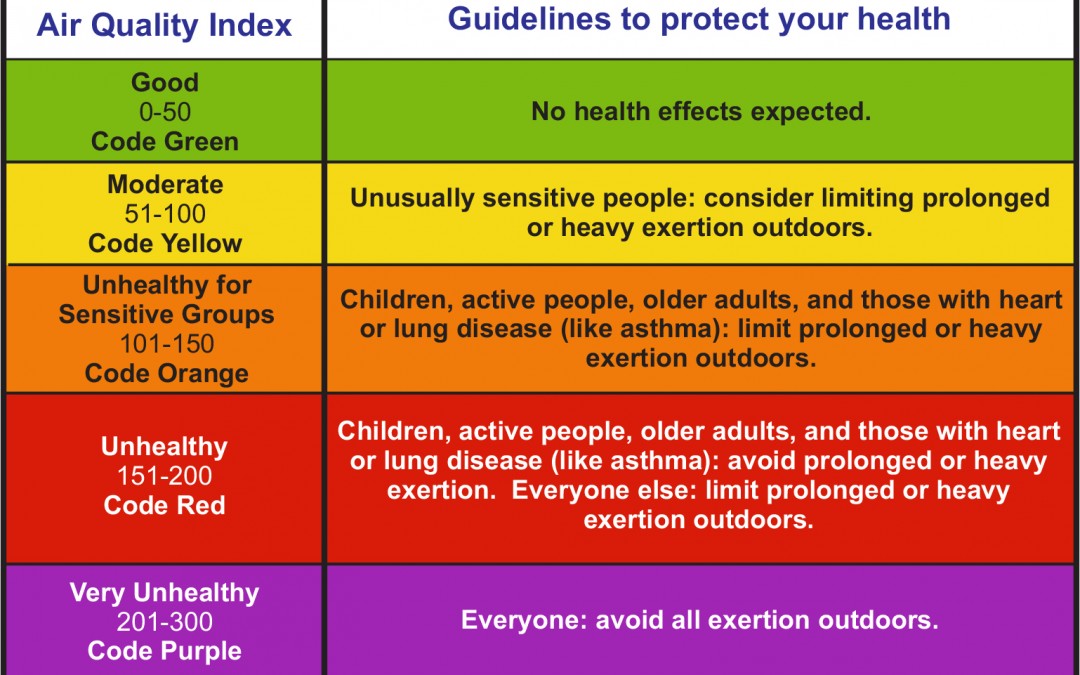The forecast for Monday, November 14, 2016, calls for Code Red or “Unhealthy” conditions in the far southwestern part of North Carolina, including Transylvania County. This poses a health risk for all people, with a higher risk for children, older adults, and those with heart and lung conditions, including asthma.
Public health officials recommend that people monitor air quality conditions and “take it easy” or limit physical activity on days when the air quality conditions are Code Orange or higher.
Fine particles, like those that come from wildfires and burning wood, can penetrate deeply into the lungs and be absorbed into the bloodstream, causing or aggravating heart and lung diseases. Symptoms of exposure to high particle levels include irritation of the eyes, nose and throat; coughing; phlegm; chest pain or tightness; shortness of breath and asthma attacks.
High particle levels—as seen on days with Code Orange or higher conditions—can impair breathing and aggravate symptoms in people with heart and respiratory problems, and irritate the lungs in healthy individuals. People with chronic lung and heart ailments, as well as children and older adults, should reduce physical exertion and outdoor activity.
Increased physical activity requires people to breathe faster, breathe deeper, take in more air—and therefore, more air pollution—into their lungs. Any activity that raises the breathing rate increases the health risk.
With Code Red conditions like those expected on Monday, most people don’t need to stay indoors, but should take frequent breaks and reduce the intensity of physical activity outdoors.
However, certain groups of people may be more sensitive to air pollution from fine particles and may need to take extra precautions. Sensitive groups include children, older adults, and people with heart disease or respiratory problems, as well as those who work and exercise outside for extended times.
People should be aware of any health conditions that may increase health risks and should avoid prolonged or heavy exertion both outside and indoors on days with Code Orange or higher conditions.
Particles also can penetrate indoors, especially if ventilation systems draw in air from outside. It also comes in through doors, windows, and small openings. Therefore, indoor particle levels may be higher than normal on high particle pollution days. Supplemental use of properly sized HEPA-Charcoal air filters that do not produce ozone have been shown to improve indoor air quality by reducing particulate matter and chemicals in smoke.
When outdoor pollution levels are high enough, even indoor activity should be limited, especially for people with heart or lung conditions, including asthma. Even inside, people should do less strenuous activity and take frequent breaks to reduce physical exertion.
The N.C. Division of Air Quality has a network of monitors that measure unhealthy levels of particle pollution. State and local officials issue daily air quality forecasts for particle pollution year-round. Particle pollution can be high at any time of day or night, and the highest levels typically occur in areas around wildfires.
To find daily air quality information, visit the N.C. Division of Air Quality website at www.ncair.org, download a free mobile phone app by searching for “EPA AirNow” or sign up for daily air quality notifications by email or Twitter at www.enviroflash.info.
However, monitors are not always situated where smoke is heaviest. Therefore, the N.C. Division of Air Quality created a guide to show what levels of air pollution are likely based on visibility. If visibility is less than 1 mile due to smoke, then air quality probably is in the Code Purple or “very unhealthy” range. If visibility is from 3 to 5 miles, then air quality probably is in the Code Red or “unhealthy” range. Visibility information can be obtained from local airports or the National Weather Service.
“Your own observations will be the best guide for determining how the smoke is affecting air quality in your area,” said Division of Air Quality Deputy Director Mike Abraczinskas said. “If you can see heavy haze and smell smoke, then air quality is not good and you should limit your outdoor activities.”

